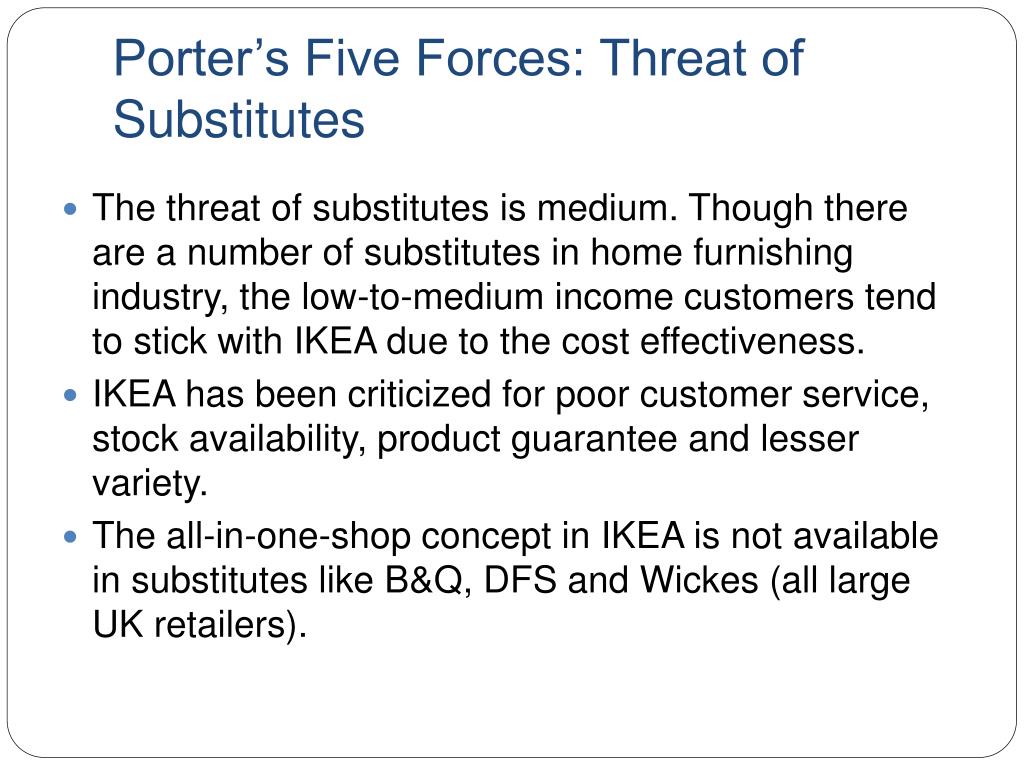

The first method applied was a semi-structured interview according to Bryman and Bell (2011) with The case company’s designer, using a predefined questionnaire with open questions. Information for this report was gathered through primary sources such as interviewees and observations as well as secondary sources such as literature research.

How does rivalry in a market as well as customer expectations influence the process of a design concept from a business perspective? 1.3. Finally it will be critically reflected up on the case company’s current situation and opportunities for the future. This report will critically analyse the design concepts for the case company by competiveness and customer expectations. This is intended to be done by creating a new line of high quality home office supplies that should be distributed via a to-be-set-up webshop putting emphasis on the Swedish craftsmanship of their products 1.

Ikea threat of new entrants free#
Today The case company wants to break free from its dusty image and restart after yet another bankruptcy. Its peak reached the company in the 1960s to 1970s when more than 200 employees worked in the factory and a signature box, the Unica box was created. The company went bankrupt several times throughout their history and managed to successfully restart from scratch. It has strong associations to its roots in Småland. The case company has a more than 200 year tradition of making stable, high quality paper products such as boxes and cardboard suitcases. In this project a papermill, is discussed. These hurdles can be circumvented by doing a thorough competitor analysis so that no unpleasant surprise waits around the corner. The desire to expand or enter a new market can lead to many avoidable mistakes. Competition can make or break a products future. Besides being aware of the motivation for a product introduction, knowing the products market is crucial. Knowing the customer’s desires helps to develop meaningful products that meet market demands. To create a meaningful, successful product, market insights and knowledge about customer expectations are needed. Then, the context of the project task is described, explaining why competitor analysis and customer expectations are crucial for a product launch. In the first chapter, the background of the report will be set, introducing the project and company The case company. These finding emphasizes how important it is to base a product development not only on emotions and assumptions, but on facts and a well-done market research. However, there are opportunities in further markets for fiber board products that look more promising, e.g. Furthermore is there a clash of the companies own idealization of their products and customer perception of The case company’s products. The analysis showed that there is very high rivalry among competitors in the home office accessory market and little chance for The case company to enter successfully. Afterwards Millers insights on customer expectations are applied on the design concepts. This method is used to determine profitability and chances of a product launch on the marketplace of home office supplies. Porter’s five forces method is presented as a tool to analyze market rivalry among competitors within the market of stationary. The company wants to launch a new product range of home office stationary, entering a new market for products made by fiber board. In this report a papermill, The case company is discussed as an example. To develop a successful product knowing competitors and customer needs can avoid many obstacles where market demands are not met.

This report describes the importance of market research and awareness of customer expectations from a business perspective in the design process for a new product. References from the World Wide Web Summary SWOT analysis of The case company and their productsħ.8. Visualization of competitors productsħ.4. Results from the perspective of customer expectationsħ.2. Results from the perspective of competivenessĥ.2. Analysis of design concepts from a business perspectiveĥ.1. Observation in the manufacturing facilities and artefact analysisĤ. Interview with The case company’s designerģ.2. Customer expectation according to Millerģ.1. Market competiveness according to Porter’s Five ForcesĢ.2.


 0 kommentar(er)
0 kommentar(er)
